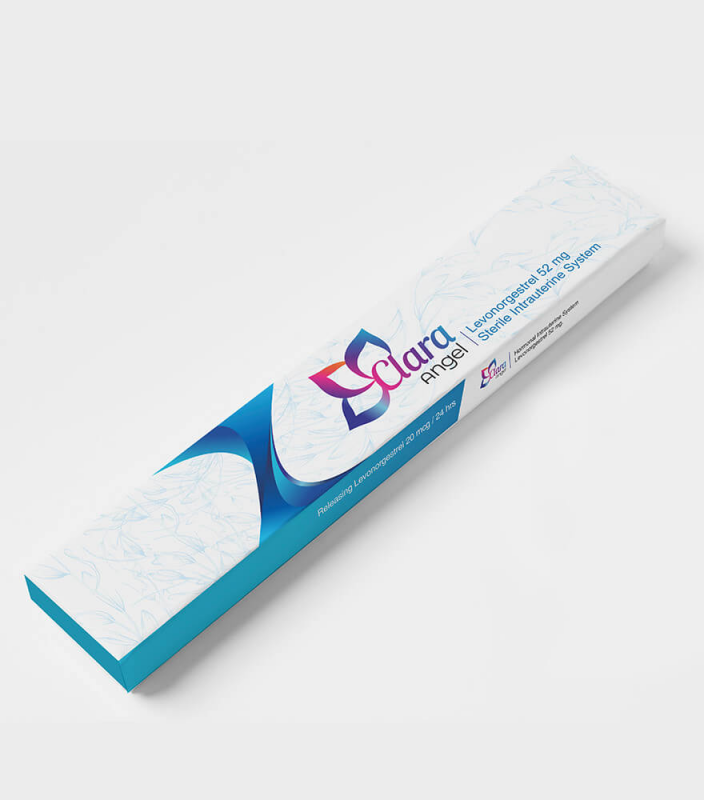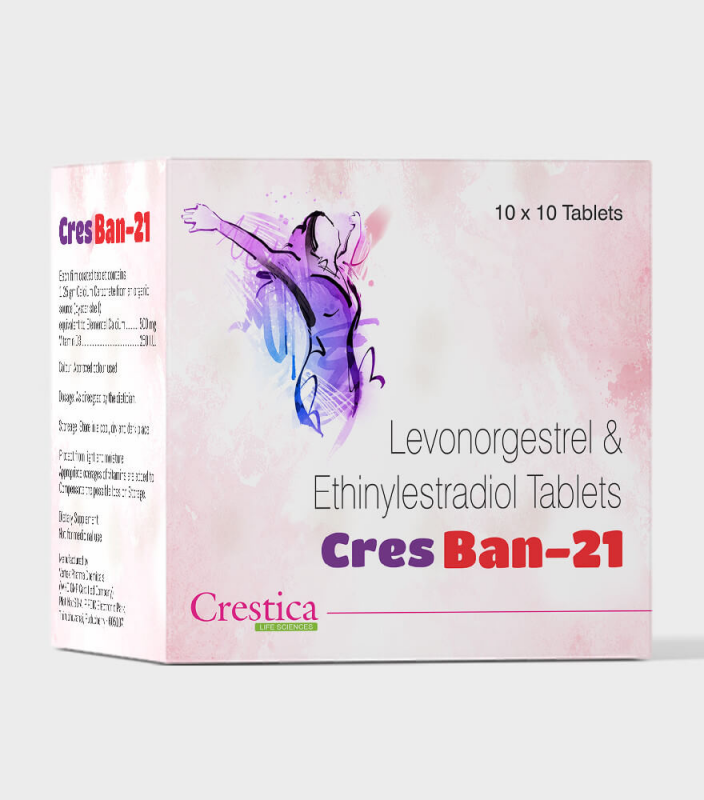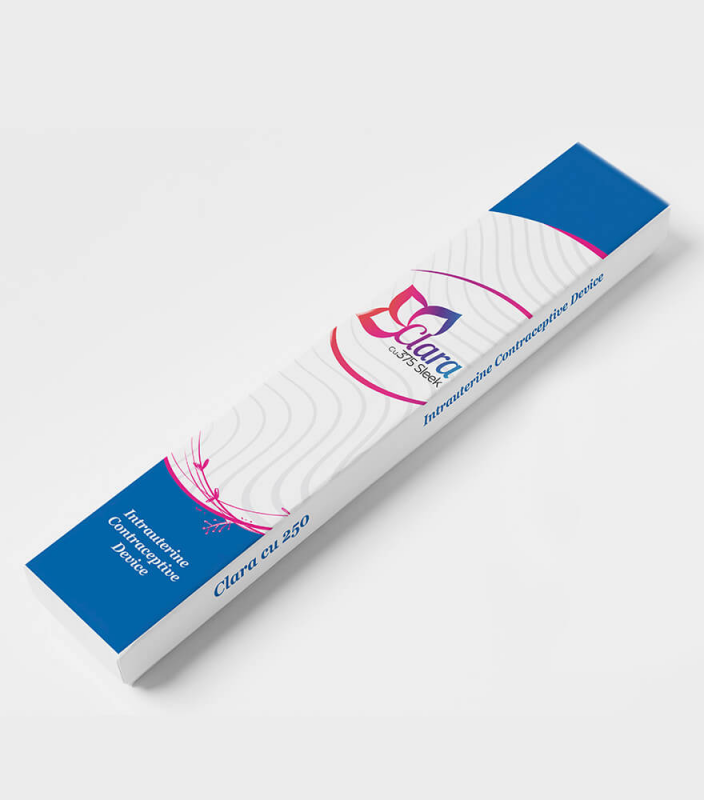Clara Angle (IUS) Intrauterine Delivery System is a hormone-releasing device for long-term birth control (contraception). It is a T-shaped intrauterine device (IUD) placed inside the womb (uterus) where it slowly releases the hormone levonorgestrel.
Clara Angle Intrauterine Delivery System is also used to treat heavy periods (heavy menstrual bleeding). It should be inserted by the doctor or healthcare professional. It remains implanted in your womb for several years and is safe to use effectively for 5 years. However, it can be removed easily when you plan a pregnancy. You should follow your doctor's advice while using this device. Your doctor may suggest a follow-up examination after 4-12 weeks of inserting the device.
You may experience cramps, bleeding, or dizziness after device insertion, consult your doctor if it lasts for more than 30 minutes. Before using this device, inform your doctor about all other medicines you are taking as many of these may make this medicine less effective or change the way it works.
USES OF Clara Angle IUS
Contraception
Brief on Contraception
Birth control, also known as contraception, is designed to prevent pregnancy. Birth control methods may work in a number of different ways and helps to avoid unwanted pregnancy.
Different ways to prevent sperm from getting to the eggs are:
1. Use of protection such as condoms, diaphragms, cervical caps, and contraceptive sponges.
2. Keeping the woman's ovaries from releasing eggs that could be fertilized. Types include birth control pills, patches, shots, vaginal rings, and emergency contraceptive pills.
3. IUDs, devices which are implanted into the uterus. They can be kept in place for several years.
4. Sterilization, which permanently prevents a woman from getting pregnant or a man from being able to get a woman pregnant
Your choice of birth control should depend on several factors such as:
1. Individual’s health
2. Frequency of sexual activity
3. Number of sexual partners
4. Desire to have children
Heavy menstrual bleeding
Brief on Heavy Menstrual bleeding
Menorrhagia (heavy menstrual bleeding) is defined as excessive and prolonged menstrual bleeding, occurring at regular intervals. Normal menstrual period lasts for 4 to 5 days with 25 to 80 ml of blood loss. Menorrhagia is said to occur when blood loss is greater than 80 ml or if the bleeding lasts for more than 7 days.
It is also commonly known as hypermenorrhea.
Causes and Risk Factors
The cause of menorrhagia is usually not identified. Some of the causes that may be associated with the problem include:
1. Ovarian endocrine disorder or dysfunctional uterine bleeding (DUB)
2. Blood coagulation disorders: Immune thrombocytopenic purpura (ITP), von Willebrand disease
3. Drugs such as anticoagulants
4. Menopause
5. Intrauterine contraceptives devices
6. Uterine fibroids
7. Endometrial infection
8. Endometrial abnormalities, e.g., endometriosis, adenomyosis
9. Endometrial carcinoma (cancer of inner lining of uterus)
10. Excess anxiety, stress, and tension
Signs and Symptoms
1. Menstrual bleeding for more than 7 days
2. Excessive bleeding that may soak one or more sanitary pads every hour for a number of hours
3. Shortness of breath, tiredness, fatigue during menstrual period
4. Large blood clots during menstrual period
Investigations
1. Pelvic and rectal examination (for any abnormality or cause of bleeding)
2. Pelvic ultrasound (to check for any structural abnormality)
3. Pap smear (scrapings of cells from inner lining of cervix are examined microscopically for any cancerous changes)
4. Endometrial biopsy (to rule out atypical hyperplasia or endometrial cancer)
5. Hysteroscopy (endoscopic examination of uterine cavity)
6. Bleeding time and coagulation tests
7. Platelet function studies
8. D&C (dilation and curettage) operation -- done to collect scrapings from the inner wall of uterus, which is then examined microscopically for any hormonal abnormality/disorders.
Treatment
1. In mild cases with less bleeding, no treatment is usually required.
2. All patients with menorrhagia are advised bed rest, to avoid exertion, vigorous exercise, anxiety, and tension.
3. Medications
BENEFITS OF Clara Angle IUS
In Contraception
Clara Angle Intrauterine Delivery System is a device that stops you from getting pregnant. It is a reliable and safe method for contraception, if used correctly. It does not interrupt with sex and you can lead a normal routine life without any worries. Follow your doctor’s instructions carefully to get maximum benefit.
In Heavy menstrual bleeding
Clara Intrauterine Delivery System slows the growth of the lining of the womb before menstruation, which reduces the bleeding during menstruation. If heavy periods become such a problem that they interfere with your everyday life, then try taking things a little easier on those days. Some women find that relaxation techniques or yoga help them feel more relaxed and reduce stress. Getting a lot of exercise can also help.
SIDE EFFECTS OF Clara Angle IUS
Most side effects do not require any medical attention and disappear as your body adjusts to the medicine. Consult your doctor if they persist or if you’re worried about them
Common side effects of Clara Angle
- Irregular uterine bleeding
- Ovarian cysts
- Pelvic pain
- Dizziness
HOW Clara Angle IUS WORKS
Clara Angle Intrauterine Delivery System is placed inside the womb (uterus) where it slowly releases the hormone levonorgestrel. This hormone may work in several ways. It may thicken cervical mucus, which affects sperm movement in the uterus. It also makes the lining of the uterus thinner. It may also stop the release of egg from the ovaries. These actions may held responsible for its various therapeutic effects.
Helpful tips
- Clara Angle Intrauterine Delivery System helps in preventing pregnancy.It may also be used to relieve heavy menstrual periods and as a part of hormone replacement therapy (HRT).
- It should be inserted by the doctor or healthcare professional. It stays implanted in uterus (womb) for many years and can be use effectively for 5 years.
- You may experience vaginal bleeding or spotting and abdominal pain while device insertion. Consult your doctor if it lasts for more than 30 minutes.
- It can be removed anytime before 5 years, and your ability to get pregnant restores immediately.
Drug Information
Chemical Class - Progesterone Congeners
Habit Forming - No
Therapeutic Class - GYNAECOLOGICAL
Action Class - Progestins (Second generation)
Q&A
Q. What is Clara Angle Intrauterine Delivery System and what it is used for?
Clara Angle Intrauterine Delivery System is a device, placed inside the uterus. It contains Levonorgestrel, a type of progesterone (a female sex hormone) which is released slowly once the device is inserted. It is used as a long-term (5 years) method of contraception (to prevent pregnancy). It may also be used to relieve heavy menstrual periods and as a part of hormone replacement therapy (HRT).
Q. When and how to use Clara Angle Intrauterine Delivery System?
For the first time Clara Angle Intrauterine Delivery System is usually inserted either during your periods or within seven days from the beginning of your period, if it is being recommended for contraception or for heavy menstrual bleeding. If you already have Clara Angle Intrauterine Delivery System placed and it is time to replace with new one, then you do not have to wait for your periods. For HRT, it may be inserted anytime. It is inserted by the doctor or trained nurse at a health care facility.
Q. For how long, Clara Angle Intrauterine Delivery System provides contraception?
It prevents pregnancy until it is removed or up to a maximum of 5 years.
Q. Does Clara Angle Intrauterine Delivery System provide 100% protection from pregnancy?
No, Clara Angle Intrauterine Delivery System is 99% effective which means that 1 out of 100 women using Clara Angle Intrauterine Delivery System may get pregnant.
Q. Can I become pregnant after I stop using Clara Angle Intrauterine Delivery System?
Yes, your fertility returns to normal immediately after you stop using Clara Angle Intrauterine Delivery System.
Q. What are the common side effects of using Clara Angle Intrauterine Delivery System?
The common side effects of using Clara Angle Intrauterine Delivery System are vaginal bleeding, infrequent menstrual periods, abdominal cramping, headache, weight gain, nausea, and acne. Most of them are temporary, however, if these side effects persist consult with your doctor.
Disclaimer:
Crestica’s intention is to ensure that its consumers get information that is expert-reviewed, accurate and trustworthy. However, the information contained herein should NOT be used as a substitute for the advice of a qualified physician. The information provided here is for informational purposes only. This may not cover everything about particular health conditions, lab tests, medicines, all possible side effects, drug interactions, warnings, alerts, etc. Please consult your doctor and discuss all your queries related to any disease or medicine. We intend to support, not replace, the doctor-patient relationship.



